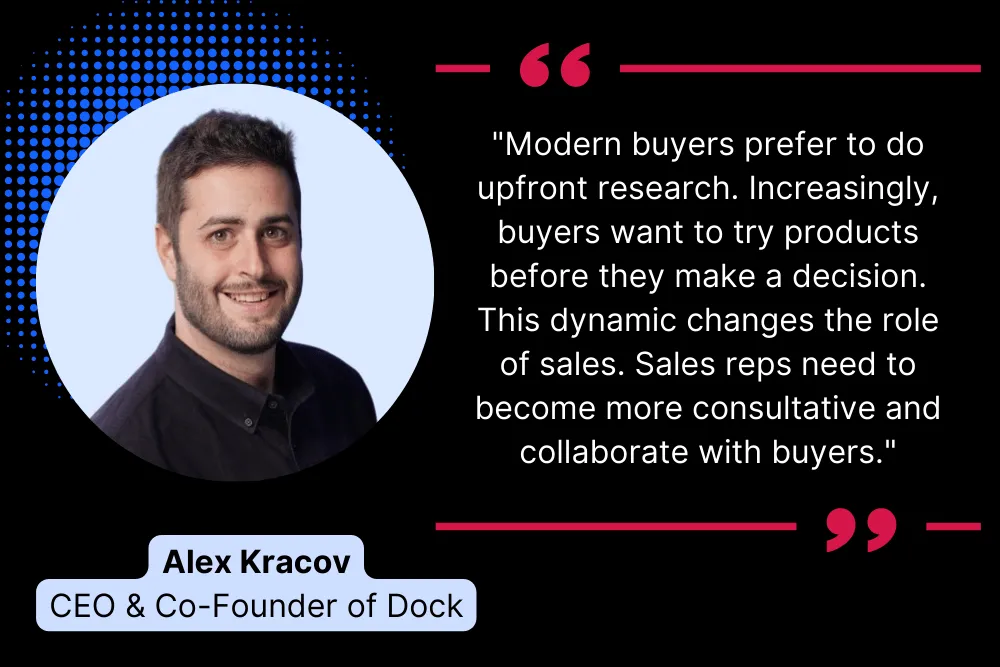
E-commerce sales trends continue to demonstrate robust growth, as the latest U.S. Census Bureau report indicates.
For the third quarter of 2023, U.S. retail e-commerce sales reached $284.1 billion, marking a 2.3 percent increase from the previous quarter. This growth is part of a broader trend in both B2B and B2C sectors, where digital platforms are becoming increasingly central.
Sales trends in e-commerce are reshaping the business landscape. Gartner predicts that by 2025, most B2B customer interactions, about eight out of 10, will occur through digital channels. This shift towards online platforms is not just a passing trend but a fundamental change in sales dynamics.
In response to these evolving sales trends, sales teams are adopting more virtual tools and advanced CRM platforms, underscoring the importance of adapting sales strategies to the changing behaviors of B2B buyers.
With recent insights revealing that 83 percent of sales leaders acknowledge their teams' struggles in adapting to evolving customer needs and expectations, it's clear that a modern approach to sales enablement is essential.
This article will delve into the leading sales trends driving B2B buyers and the strategies necessary to thrive in this competitive landscape.
How Often Should a Sales Strategy Be Updated?
B2B sales is not a short-term strategy. Nearly 75 percent of B2B sales take four months or longer to close. For new customers, more than 30 percent of deals take 10 months or longer. So, you want to create a solid sales and marketing plan and stick with it to be successful.
That doesn’t mean that you don’t evolve and update your plans as needed. Most organizations put together annual sales plans and then review them quarterly to make any major adjustments needed. Sales managers also typically review each month’s results and look ahead for patterns that indicate a change is needed based on forecasts and goals.
Even the best sales strategy can go awry due to things outside of your control. We’ve all seen that over the past few years. The pandemic, inflation, economic uncertainty, and supply chain problems have forced businesses to adapt. Plus, you can’t control what your competition does.
The sales plan needs to be a living, breathing document that evolves to meet new challenges.
9 Sales Trends You Need to Embrace Now
To stay current and competitive, sales leaders need to consider adding to their sales strategy, as well as preparing for the future. Even the way sales organizations look at sales growth has changed in recent times. As Ryan Iacoviello of UserGems explains it:
“Shifting from growth at all costs to measured growth is the #1 change. Do more with less is the mandate of every board. Reduce costs, tools, and headcount. What was a 3x growth target is now 2x.”
Here are some of the top trends industry leaders are embracing to beat revenue goals, despite shifting world conditions.
1. Automation & Artificial Intelligence
AI isn’t exactly new, but the way it’s being used has changed over the past year.
“One of the biggest trends that I expect to see in 2024 is the increased use of AI,” says Will Yang, Head of Growth at Instrumentl. “In the last few years, we've seen sales teams experimenting with AI at all levels—in the form of chatbots, virtual assistants, and even automated recommendation engines. These tools are already proving to be extremely valuable for sales teams, as they allow for more time to be spent on strategic discussions about how to upsell or cross-sell.”
Automation is also key to tracking customer data and smoothing out workflows. The best CRM platforms, like Close, will allow you to automate workflow automatically:
- Importing prospects into your CRM
- Sending personalized emails to prospects
- Creating automated email, SMS, and calling sequences to close more deals
- Scoring leads based on clear criteria
Sales automation tools streamline tasks so you can free up time to spend on prospecting and generating leads, qualified leads, and nurturing leads through the buyer’s journey. When you can automate and handle tasks with one comprehensive, all-in-one CRM, you can also work more efficiently. For example, tools like smart views and lead filtering, email workflows, and integrated dialers can all reduce manual workflow.
At the same time, because you are capturing data from every touchpoint that goes far beyond just demographics, you can provide a consistently better customer experience throughout the entire sales cycle.
Intrigued by the potential of AI in sales? Dive deeper into the topic by reading our thought-provoking article, "The Future of AI in Sales: What Changed and What’s Next."
And if you want to know the benefits of AI in B2B sales, this article has all the insights. Also, we have a great article on B2B CRMs - just mentioning, in case you want to check it out.
2. Implementing Social Selling Strategies
Social selling is a strategic way of connecting with prospects and building relationships using social media. For B2B sellers, LinkedIn has become a powerful tool. There are many reasons this works so well including building trust. When you connect with someone on LinkedIn, they can easily click over to your profile to see who you are. This can provide instant credibility.
You can also examine a prospect’s social media to look for areas where you might have common ground to foster discussions.
LinkedIn also gets you in touch directly with key decision-makers. The social platform for business claims more than 65+ million decision-makers use the platform.
Sales reps need to make sure they have a robust profile and are active on LinkedIn whether they plan to use the platform to prospect or not. There’s a good chance prospects will look you up to see who they’re dealing with. More than half of decision-makers surveyed by LinkedIn say they use thought leadership content to determine which organization they work with.
LinkedIn also provides a way to conduct basic market research and keep an eye on market trends that may help in nurturing prospects. This information can help you craft effective value narratives to create engagement and keep your sales pipeline full.
3. Faster, Better Data Availability and Use
Research from McKinsey shows that the fastest-growing companies excel at using data analytics better than their peers. The right CRM platform can provide the key data points sales teams need to make sure they are on track to meet and exceed their quotas. This allows you to get past sales figures and drill down to the sales analytics that move the needle.
One key trend in the world of sales data is what Ryan Doyle of Magic Sales Bot calls pre-intent data:
“We're sending tens of thousands of cold emails per month. We're seeing the biggest growth from campaigns that make use of pre-intent data: Companies posting jobs that hint at their initiatives in the descriptions, SEC filings that reveal CEO focus, all the things that come *before* the company starts googling, talking to peers, to salespeople. If we can get in before that, we can often be their sole consideration.”
 |
Here’s an article from Ryan Doyle on Sales Hacker that goes into more detail.
“I’ve been seeing an increasing importance in tech and data in sales,” says Valentin Wallyn, Founder of Findymail. “There is a big difference between a sales org that has their IT team do the necessary work to ensure good email deliverability in their outreach vs those who have not and end up in spam.
“Same story with the data: Those that have the most relevant automatic trigger can reach prospects at a relevant time and close the deal. Those who don't have those technologies struggle.”
Find out how utilizing intent data providers can optimize your conversion rate.
4. More Async Sales Actions
We talked with Noam Horenczyk of Walnut.io about selling to Millennials and Gen Z in B2B, and he brought up the fact that virtually 100 percent of buyers now want a self-serve option for at least part of their buying process.
Speed is key for the modern buyer, which means they want to get through the purchase process at their own pace when it makes sense for them.
This leads to new sales trends that are more asynchronous, such as on-demand product demos or other resources prospects can use to move through the buying process without the direct help of a sales rep.
Alex Kracov, CEO and Co-Founder of Dock talks about how he’s seen this trend develop: "Buyers are spending less time talking to sales teams. In the past, sales reps were gatekeepers for information. You needed to talk to sales to learn about the product, get access to a free trial or understand pricing.
 |
“Modern buyers prefer to do upfront research on sites like G2 or in different online communities. Increasingly, buyers want to try products before they make a decision, which has led to the rise of product-led software companies. This dynamic changes the role of sales. Sales reps need to become more consultative and collaborate with buyers. The best sales reps curate information for buyers, answer specific product questions, and lead them through the sales process.
“At Dock, we've seen growing demand for digital sales rooms as a way for sales teams to collaborate with buyers throughout the sales process."
And the trend towards async sales has started to influence even the industries that have always relied on in-person selling. As Emma O’Connor, Head of Sales and Marketing at House Buyer Network says:
“What we've seen, and I believe we'll become more reliant on, is sales via video. Even when purchasing high-ticket items like cars or houses, buyers are reluctant to view them in person, preferring to have a walk-through or demo via video.
“Be prepared to sell by async video. As most of us are communicating asynchronously for work, it's natural that it will flow over into other parts of our lives including buying products. Businesses need to get up to speed and add to their tech stack if they're not up and running on async video yet.”
 |
5. Pushing Creative Boundaries for More Targeted Sales Outreach
The average business person receives more than 120 emails every day and sends another 40. That means they are handling about 800 emails every week. Executives are likely seeing more. What makes you think your email is going to stand out?
The best sales reps and sales managers know it’s creativity that often separates the winners from the losers.
Some of the creative ways salespeople have harnessed that creativity is by looking at alternative ways beyond the norm. Examples include:
- Sending personalized swag or books in the mail
- Sending important industry trends by email
- Having loyal customers call on your behalf
- Tailor success stories that directly address prospect pain points
- Record personalized videos
As Will Yang mentions: “I expect that we'll see a movement toward more personalized and targeted selling in the next decade. The explosion of data and analytics has made it possible for companies to know more about their customers than ever before—and this information can be used to tailor sales pitches and messaging in a way that wasn't possible just five years ago.”
 |
The more personal and targeted you can make your approach, the better it works. Here’s an example of how a sales team worked collaboratively to land an exceptionally high-value target: T-Mobile. After trying unsuccessfully to connect on multiple occasions with T-Mobile’s CEO at the time, John Legere, the sales rep did a little research on Legere. What they found was that he was a huge fan of Batman. So, the marketing team created a comic book version of how their company could work with T-Mobile to solve a particular challenge. Pow!
6. Blurring the Lines Between Sales and Marketing
The days of marketing developing leads and turning them over to sales for activation and closing are over. B2B buyers no longer travel in a straight line through the sales funnel so your marketing and sales efforts need to evolve, too.
“A lot of companies still aren’t aligning sales and marketing well,” says Caroline Pegram, Sr. AE at UserGems. “It's still a blame game, which ultimately leads to higher lead spend and lower close rates, which is costing them big time.”
The solution? Sales + Marketing = Smarketing.
Smarketing requires the integration of sales and marketing processes to provide a collaborative approach to targeting and nurturing prospects through the buyer’s journey.
Sales and marketing alignment is key to growing revenue and working efficiently. It can also be a significant competitive advantage. Ninety percent of marketing and sales professionals say their organization is misaligned in strategy and processes.
“In the past, there was a pretty clear line between the sales and marketing teams,” says Matthew Ramirez, Founder of Rephrasely. “However, with the rise of content marketing, social media, and other forms of advertising that blur the lines between the two disciplines, it's become increasingly important for salespeople to be well-versed in the world of marketing. As a result, many salespeople are being trained in marketing best practices and tools, and some even have a background in marketing or communications.”
 |
Strategies to help create alignment include using consolidated KPIs rather than individual goals. For example, evaluate the success of marketing campaigns on closes or generating high-value leads rather than the number of leads.
Using content marketing in sales is also a way to align these two teams. “I think that the way content marketing intertwines with sales has transformed,” says Nebojsa Savicic, Co-Founder of Plainly. “Great content helps with educating prospects, but even more so—it helps them formulate the right type of questions which makes the sales calls more meaningful.”
When you deploy sales enablement tools and create joint goals, everyone can work together to achieve these goals, measuring and tracking performance at each step to evaluate effectiveness.
7. Shorter, More Personalized Product Demos
Visualizing solutions has always been part of the sales process, but sales strategies have evolved as well. For example, highly personalized product demos have been more common. Software-as-a-Service (SaaS) demos might include live data or even use prospects’ data to provide a real-life example of how their product works.
Nebojsa Savicic explains: “The biggest sales trend I'm already seeing relates to the nature and structure of the sales call. For example, in contrast to most SaaS companies, we reduced the time of our demo to 15 minutes. This makes it easier for our prospects to commit to booking a demo and helps us stay laser-focused on their needs. A demo is not a generalized one, but it's tailored for the person and their pain point, which is the info we collect in the contact form. This form also helps us qualify leads.”
 |
8. Investing in the Future
The best sales teams are always learning and growing. Sales managers need to invest in future technologies and training to ensure that today’s salespeople don’t remain stagnant. This goes well beyond the old VHS tapes offered to the sales teams of yesterday or even the online training sessions that are in use currently.
Interactive and personalized training can help information stick by identifying the learning styles of individuals and providing prescriptive recommendations for coaching that will be most effective. AI-fueled algorithms and machine learning can create personalized learning plans.
Sales leaders also need a more effective way to coach their reps. The right tools that are integrated with your CRM can make a difference. For example, in-app listen, whisper, and barge can provide real-time coaching to help maximize outreach.
You might also want to check out the free books, templates, and training we offer on the Close Resource page.
9. Honing in on Vertical Markets
Companies are also broadening their product lines by finding a creative way to grow in neighboring verticals. Finding another use for your existing products in another industry or sector, or finding complimentary products, can help create more sales opportunities.
A few examples include the car service Uber which launched UberEATS. Using the same backend technology that powers the Uber app and its network of drivers to compete with other food delivery providers. Electric vehicle manufacturer Tesla is in the energy storage business, creating a battery product that supports their vehicles and extends power generation to homes.
Perhaps the most successful example is Amazon, which pivoted from being a bookseller to being a full-service eCommerce site that is now vertically integrated to feature nearly every consumer product. Its predictive intelligence data now powers its recommendation engine, which accounts for nearly a third of the company’s overall revenue.
How Close CRM Helps Sales Leaders Automate
In the coming year and the days ahead, sales leaders will be tasked with continuing to stay on top of emerging trends, continued shifts in buyer behavior, and the adoption of technology that’s fueling high-performing sales teams.
Staying ahead of the competition requires automation, analytics, and collaboration. It takes a willingness to learn new skills and seek out new solutions.
That’s what we do at Close.
Close provides an SMB and startup CRM that’s built for faster workflows, and less manual effort. We believe communication is key to sales success, which is why Close enables sales teams to communicate more smoothly with their prospects and customers.
Want to see how Close can upgrade your sales strategy and keep you on track with 2023’s biggest sales trends? Watch our 10-minute on-demand demo or try Close free to see how the most powerful CRM for small business leaders can help you focus on growth.










